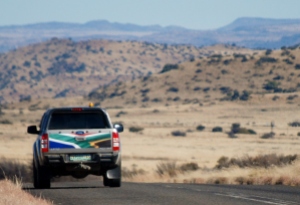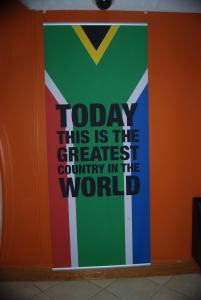Originally posted on Slugger O’Toole…
 I was interested to note the Union Flag carefully positioned immediately beside Belfast PUP Councillor Julie-Anne Corr Johnson for her interview with BBC NI’s The Viewrecently. “On one hand they tell us the British identity of Northern Ireland citizens is under threat”, she thundered, “whilst at the same time denying British citizens like me access to British laws and British rights.” The openly lesbian Corr Johnson was objecting to the DUP campaign for a ‘religious opt-out’ to equality laws for same-sex couples.
I was interested to note the Union Flag carefully positioned immediately beside Belfast PUP Councillor Julie-Anne Corr Johnson for her interview with BBC NI’s The Viewrecently. “On one hand they tell us the British identity of Northern Ireland citizens is under threat”, she thundered, “whilst at the same time denying British citizens like me access to British laws and British rights.” The openly lesbian Corr Johnson was objecting to the DUP campaign for a ‘religious opt-out’ to equality laws for same-sex couples.
It was interesting, because in Northern Ireland flags aren’t usually identified as symbols of equality or human rights. In particular, those most likely to consider the Union Flag an important political symbol have traditionally been those in Northern Ireland least likely to support gay rights; on gay pride marches, neither Union Flags nor Tricolours are to be seen at all. In that context, Corr Johnson’s positioning of herself with the flag was an interesting and clever subversion of the accepted political order. I’m a Unionist and a Loyalist too, Corr Johnson was saying, and actually people like me are the ones committed to actual British values, not the DUP and TUV.
That sort of cultural positioning and visual imagery is common in the United States, where the flag and Constitution seem to outsiders almost to be objects of worship. Over there, claiming a share in the flag is now a core strategy of not just LGBT activists, but minority activists in general. Was it always thus?
One of my favourite scenes from the inspiring if hagiographic biopic Milk, is that where the eponymous hero takes a leading part in the 1978 Gay Freedom Day Parade as San Francisco’s first openly gay councillor. Behind him in the cinematic recreation, a gay teachers’ association contingent flies several gigantic Stars and Stripes, one of them carried by an African-American woman, as they parade down Polk Street through the gay ghetto. “This is our country too” is the silent message conveyed by the images
[youtube=https://www.youtube.com/watch?v=jD3GF_1D4U0&w=300]The scene was pure fiction, a film director’s reinterpretation of what would be politically useful in 2008 to have happened. Surviving video footage of the actual 1978 Freedom Day Parade on YouTube, in contrast, shows a single, rather small, Stars and Stripes being flown over the course of about nine minutes. At San Francisco City Hall, the rainbow flag alternates with the Bear Flag of the State of California, with Old Glory nowhere in sight. It is easy to forget from the current vantage that these were the years after Watergate and the conclusion of the Vietnam ignominy, when American patriotism ebbed at all-time lows. San Francisco was the most left-wing major city in the US, and that political hue was still brighter in a gay and lesbian community largely composed of those who fled bigotry by conservatives wrapping themselves in the flag in the heartland. Indeed, across the Western world, the young and urban in 1978 were sure they were going to reinvent society, ending its petit bourgeois obsession with national chauvinism and militarism.
In the main, San Francisco gays in 1978 didn’t want to become respectable parts of American society – they were too busy questioning the whole concept of American society. And that of respectability.
Those were the days before AIDS, before Reagan, before the end of the Cold War and long before 9/11. It’s not just that the past is a different country where they do things differently; it’s that we constantly reinvent our pasts to suit our presents. The meanings of flags, like all repositories of communal identity, are constantly changing.
In deeply divided societies, flags can be particularly divisive; but they can, even in the most challenging contexts, unite.
In 2011, I was on a rally organised by people from Khayelitsha, Cape Town’s largest and poorest slum, for better sanitation (this is the sort of thing that High Anglican missionaries do). In parts of the township, 30 families share one toilet. It’s not an issue that most of us really understand the consequences of – from being late for work because of the size of the early morning loo queue, to women having to walk some of the most dangerous streets in the world in the middle of the night because they have a call of nature, to the townships’ catastrophic levels of infant death from diarrhoea. That lack of understanding applies equally to middle-class South Africans. And so on a gorgeous day in late April autumn, I was one of maybe 100 White people and ever fewer Coloured people in a crowd of 20,000 at Cape Town’s Council Offices. All of modern South Africa’s divisions were right around me: new to the country, it seemed to embody the death of the dream of the Rainbow Nation.
After a bit of speechifying in three languages, and a bit of boogieing to a set by a local kwaito hip-hop act, proceedings concluded with the National Anthem. In front of me were three Black township kids, maybe nine or ten years old. Having turned about 20 degrees to face the flag, they started belting out Nkosi Sikelel’ iAfrica at the top of their voices with hands on heart. I wondered what would happen when it came to the last part, when the key and tune change to the final verse of the old, apartheid era, national anthem, two lines in Afrikaans and two lines in English. I watched closely.
And afterwards I felt almost embarrassed that I had, because they just continued belting it all out, hands on hearts, “Uit die blou van onze hemel” – what had once not only been the language of the oppressor, but the very anthem of the oppressor. But to these lads, born perhaps desperately poor but as free and equal citizens in 2001 or 2002, it wasn’t any of those things. It was just the National Anthem. And they were obviously proud of their country, as they have every right to be.
 It works the other way too. Afrikaner owned farms seem to compete to see which can fly the most ludicrously oversized flag. The Cape-vs-North divide in Afrikaner identity has always been profound, so I wondered would it be the same up North as in the more genteel territory of Cape Winelands and the Garden Route which I got to know first. But in the Eastern Free State, conservative Afrikaner farmers draped the flag on their pickup trucks. In the tidy little dorps strung along the N1 Cape to Jo’burg road through the desert, most of the shops – and the shops are still mostly White-owned – had the flag flying somewhere, if not in the window, then on a counter display or poster.
It works the other way too. Afrikaner owned farms seem to compete to see which can fly the most ludicrously oversized flag. The Cape-vs-North divide in Afrikaner identity has always been profound, so I wondered would it be the same up North as in the more genteel territory of Cape Winelands and the Garden Route which I got to know first. But in the Eastern Free State, conservative Afrikaner farmers draped the flag on their pickup trucks. In the tidy little dorps strung along the N1 Cape to Jo’burg road through the desert, most of the shops – and the shops are still mostly White-owned – had the flag flying somewhere, if not in the window, then on a counter display or poster.
It’s not that South Africa doesn’t have its problems with racial divisions. It has the obvious ones, like the 9:1 wealth gap and 7:1 unemployment rate gap between Whites and Blacks. Illiteracy and AIDS are enormous social problems – but not for Whites. The standard of discourse on talk radio would make Stephen Nolan blush. There are also the subtle things: in small towns, the pubs all seemed to be mixed, but Whites and Coloureds always seem to be in the main bar, and blacks in the Lounge. Everybody was perfectly nice in those places but there was little real social contact, not helped by the fact that few Whites or Coloureds speak any African languages, and few Blacks want to struggle through Saturday night conversations in a second or third language after a few beers.
In most ways, South Africa is a profoundly more divided society than Northern Ireland: yet the flag and the anthem are about the only things that unite it, symbolising the hope that the rainbow dream of 1994 might not have been sheerest folly.
In Northern Ireland, with all our advantages of wealth, education, and personal security, why is it still so difficult to create common symbolism? There is mythology about 1994 in South Africa, but there is substance undergirding it. Similarly with the journey of 1994-2007 in Northern Ireland; common symbols would make it easier to create a mythology to embed the gains of our own recent past. We are, whether any of us likes it or not, destined to spend the foreseeable future as a semi-detached part of the UK governed under the political architecture agreed in 1998.
Why does national symbolism have an unlimited capacity to get us at each other’s throats? And is that a consequence of the dominant political forces still living in denial about the terms of the deals they signed up to in 1998 and 2007? While you can’t eat a flag, it’s yet to be demonstrated that a stable polity can be built without one.





